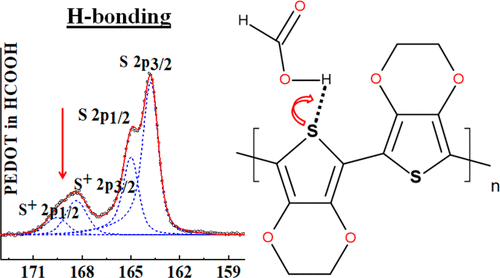当前位置:
X-MOL 学术
›
Macromolecules
›
论文详情
Our official English website, www.x-mol.net, welcomes your feedback! (Note: you will need to create a separate account there.)
Hydrogen Bonding as a Tool to Control Chain Structure of PEDOT: Electrochemical Synthesis in the Presence of Different Electrolytes
Macromolecules ( IF 5.5 ) Pub Date : 2020-03-31 , DOI: 10.1021/acs.macromol.9b02627 Iryna Ivanko 1 , Jan Svoboda 1 , Miroslava Lukešová 1 , Ivana Šeděnková 1 , Elena Tomšík 1
Macromolecules ( IF 5.5 ) Pub Date : 2020-03-31 , DOI: 10.1021/acs.macromol.9b02627 Iryna Ivanko 1 , Jan Svoboda 1 , Miroslava Lukešová 1 , Ivana Šeděnková 1 , Elena Tomšík 1
Affiliation

|
The current knowledge about the presence of cation radicals in organic semiconductors is connected with oxidized constitutional units and their interaction with counterions. In this work, we have shown that the formation of cation radicals in poly(3,4-ethylenedioxythiophene) is induced by intermolecular electrostatic interactions, particularly by hydrogen-bond formation between formic acid and polymer. Raman, XPS, UV–vis, and EPR spectroscopies were used to prove that by using the simplest carboxylic acid, which can form hydrogen bonding, it is possible to form localized cation radicals. Moreover, it was shown that by replacing formic acid with o-phosphoric acid, it is possible to obtain delocalized cation radicals. The gained new understanding how to tune the formation and nature of cation radicals in organic semiconductors can be used in the design of organic electronics.
中文翻译:

氢键作用作为控制PEDOT链结构的工具:在不同电解质存在下的电化学合成
关于有机半导体中阳离子自由基的存在的当前知识与氧化的结构单元及其与抗衡离子的相互作用有关。在这项工作中,我们已经表明,聚(3,4-乙撑二氧噻吩)中的阳离子自由基是由分子间静电相互作用引起的,尤其是甲酸和聚合物之间的氢键形成。拉曼光谱仪,XPS光谱仪,紫外可见光谱仪和EPR光谱仪用于证明通过使用最简单的可形成氢键的羧酸,可以形成局部阳离子自由基。此外,结果表明,通过用邻甲酰胺代替甲酸-磷酸中,可以获得离域的阳离子自由基。对如何调整有机半导体中阳离子自由基的形成和性质所获得的新认识可用于有机电子产品的设计。
更新日期:2020-04-24
中文翻译:

氢键作用作为控制PEDOT链结构的工具:在不同电解质存在下的电化学合成
关于有机半导体中阳离子自由基的存在的当前知识与氧化的结构单元及其与抗衡离子的相互作用有关。在这项工作中,我们已经表明,聚(3,4-乙撑二氧噻吩)中的阳离子自由基是由分子间静电相互作用引起的,尤其是甲酸和聚合物之间的氢键形成。拉曼光谱仪,XPS光谱仪,紫外可见光谱仪和EPR光谱仪用于证明通过使用最简单的可形成氢键的羧酸,可以形成局部阳离子自由基。此外,结果表明,通过用邻甲酰胺代替甲酸-磷酸中,可以获得离域的阳离子自由基。对如何调整有机半导体中阳离子自由基的形成和性质所获得的新认识可用于有机电子产品的设计。


























 京公网安备 11010802027423号
京公网安备 11010802027423号